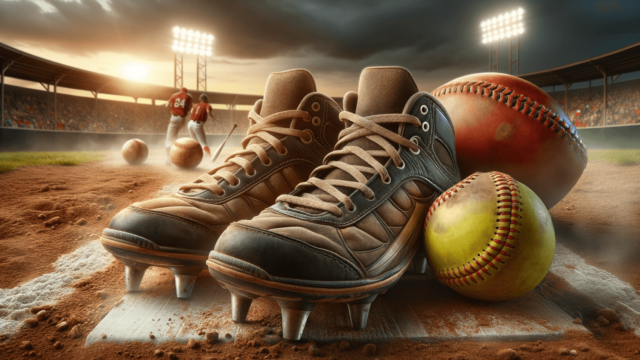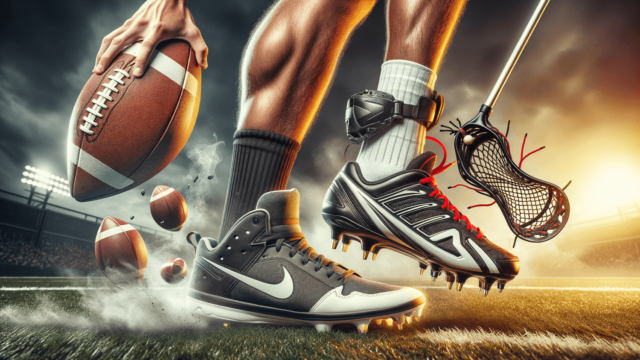
No, you cannot wear baseball cleats for football as they have different cleat patterns, designed specifically for their respective sports, and using them interchangeably may lead to poor performance and increased risk of injury.
Understanding the Differences Between Baseball and Football Cleats
Though baseball and football cleats may look similar, they serve distinct purposes in their respective sports. Key differences lie in the cleat patterns, materials, and support levels.
Cleat Patterns
Baseball cleats typically have a toe cleat at the front for quick starts and lateral movements, while football cleats do not. Football cleats, on the other hand, feature more studs spread across the sole for better traction and stability on the field.
Materials and Support
Football cleats are designed to provide better ankle support than baseball cleats. The materials used in football cleats are generally more robust, considering the aggressive nature of the sport.
Why Wearing Baseball Cleats for Football Is Not Recommended
Inadequate Traction
Due to the different cleat patterns, wearing baseball cleats in football can lead to inadequate traction, causing reduced performance, slipping, or tripping during gameplay.
Risk of Injury
Using baseball cleats in football can increase the risk of injury, as the lack of ankle support may lead to sprains, strains, or other related injuries.
Violation of Sports Rules
Most leagues and associations enforce specific rules about the types of cleats players can wear, and using baseball cleats for football is usually prohibited.
Choosing the Right Cleats for Football
Consider Field Type and Conditions
Selecting the appropriate football cleats depends on the field type and weather conditions; there are 3 types: molded, detachable, and turf.
Choose the Desired Comfort and Support
Your position and personal preference will determine whether you need a high, mid, or low-cut cleat for optimal comfort and support.
Find the Appropriate Size
Proper sizing is essential for optimum performance and preventing injuries. Properly fitted cleats should feel snug but not too tight.
Selecting the Right Cleats for Baseball
Choosing the appropriate cleats for baseball is equally important for ensuring safety, comfort, and optimal performance on the field.
Identify Player’s Position and Gameplay Requirements
Based on the position you play, focus on the features specific to your needs. Pitchers will likely prioritize grip, while infield and outfield players need cleats that promote speed and agility.
Examine Different Types of Cleats
Baseball cleats are available in a variety of types, including metal, molded plastic, and turf shoes. Each type offers unique benefits suitable for different field types and conditions.
Focus on Comfort and Fit
Achieving a comfortable fit prevents injuries and allows players to perform at their best. Cushioning, support, and proper sizing are essential factors for finding the ideal baseball cleat.
Proper Care and Maintenance of Cleats
Regardless of the sport, proper care and maintenance of your cleats can significantly extend their lifespan and ensure they remain in good condition.
Clean After Use
Remove dirt and debris from your cleats after each use to prevent the buildup of grime and bacteria, which can damage the materials and produce unpleasant odors.
Dry Them Properly
Avoid exposing your cleats to direct heat sources, as it can weaken the materials. Instead, air dry them in a well-ventilated area away from direct sunlight.
Inspect Regularly for Wear and Tear
Regularly check your cleats for any signs of damage, such as worn-out studs or broken laces. Replace the insoles or damaged cleats when necessary to continue enjoying their benefits.
The Importance of Wearing Sport-Specific Cleats
Each sport has unique requirements, and sport-specific cleats are engineered to meet those needs, ensuring a safer, more enjoyable playing experience. Using appropriate footwear can not only enhance performance but also reduce the risk of injury and comply with rules set by leagues and associations.
Frequently Asked Questions
After reading about the differences between baseball and football cleats, you may have some further questions. Here, we answer five of the most commonly asked questions to help clarify any remaining confusion.
Can I wear soccer cleats for football or baseball?
No, soccer cleats should not be worn for football or baseball, as they lack the required features and support specific to each sport, which can result in poor performance and increased risk of injury.
What is the primary difference between molded and detachable cleats?
Molded cleats are permanently attached to the shoe’s sole and provide consistent traction, whereas detachable cleats feature removable studs, allowing players to customize the cleat configuration based on field conditions and personal preferences.
When should I replace my cleats?
Replace your cleats when they show significant signs of wear and tear, such as a loose or damaged cleat plate, excessive stud wear, or material breakdown in the upper part of the shoe. Doing so ensures optimal performance and protection against injury.
Can I use the same cleats for practice and competitive games?
Yes, you can use the same cleats for practice and competitive games, but it may cause them to wear out faster. Some players prefer to have a separate pair for practice, reserving their best pair for games to extend their lifespan.
Are there specific brands or models best suited for football or baseball cleats?
Several well-known brands specialize in producing high-quality cleats for both football and baseball. However, the ideal model depends on an individual’s specific needs, preferences, and budget. To find the best fit, try on various models and brands to determine which meets your requirements.
Featured Posts
- No pillar pages found.





